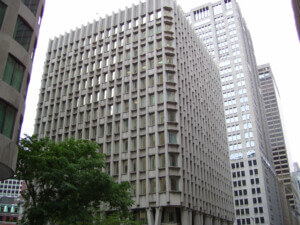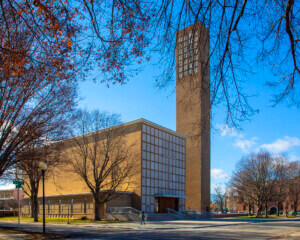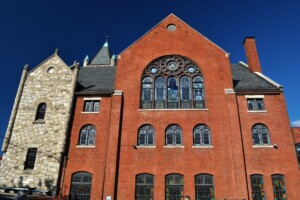Wednesday, the National Trust for Historic Preservation released its 2013 list of “America’s Most Endangered Historic Places” made up of cultural landmarks, historic houses of worship, civic spaces, derelict industrial structures, and a significant waterway. For twenty-five years, the National Trust has launched campaigns to save historic structures and places in regions across the United States—many of which are vulnerable from years of neglect or the threat of demolition. In a press conference over Twitter, President and CEO Stephanie K. Meeks explained the impetus for including these specific sites: “It’s always a tough choice, but we evaluate on significance, urgency of threat, and possible solution.” The designation, Meeks said, is a tool for drawing attention to places “in a national context of significance” that might otherwise go unnoticed.
This year’s motley list includes the likes of Gay Head Lighthouse in Martha’s Vineyard and San Jose Church in Puerto Rico built in 1532.
Abyssinian Meeting House
Portland, Maine
From the National Trust: Built in 1828, the Abyssinian Meeting House is a modest house of worship with great historic significance to the people in Maine. Serving as a school for African-American children, community center, and a stop on the Underground Railroad, the Abyssinian is the third oldest-standing African-American meeting house in the United States.
Astrodome
Houston, Texas
Architect: Hermon Lloyd & W.B. Morgan, Wilson, Morris, Crain & Anderson
From the National Trust: As the world’s first domed, indoor, air-conditioned stadium, the 18-story multi-purpose Houston Astrodome was deemed the “Eighth Wonder of the World” when it opened in 1965. It is a marvel of modern engineering, and was designed to embody Houston’s innovative, entrepreneurial and space-age development as a major U.S. city. The Astrodome was home to Major League Baseball’s Houston Astros and the National Football League’s Houston Oilers for many years, and also played host to numerous other notable events, from the “Battle of the Sexes” tennis match between Billie Jean King and Bobby Riggs in 1973, to the Republican National Convention in 1992. Without a viable reuse plan, the Astrodome will likely succumb to calls for demolition.
Chinatown House
Rancho Cucamonga, California
From the National Trust: It was built from local materials in a vernacular style in 1919 and was designated a City Landmark in 1985. The two-story brick building provided housing and a general store for a community of approximately fifty Chinese American laborers. Today, the house is one of the last tangible connections to the history of the once-thriving Chinese American community that helped build modern-day Rancho Cucamonga.
Gay Head Lighthouse
Aquinnah, Massachusetts
From the National Trust: Gay Head Lighthouse was the first lighthouse built on Martha’s Vineyard and one of the first in the U.S. to receive a first order Fresnel lens in 1856. Many men in the Aquinnah community, including members of the Wampanoag tribe, worked at the lighthouse. Standing atop the National Natural Landmark Gay Head Cliffs, the lighthouse serves as a beacon to Wampanoag tribal heritage and is the only lighthouse with a history of Native American Lighthouse keepers.
The lighthouse is in immediate danger of toppling over the edge of the Gay Head Cliffs, a consequence of a century of erosion and the direct impact of climate change. The lighthouse is 50’-60’ from the edge of the cliffs and about 10 feet away from losing its future. The rate of erosion is about 2 feet per year, and that rate can be accelerated by significant storms. It is estimated that in two years, or less, there will not be enough land left to accommodate the machinery and equipment needed to move the tower.
Historic Rural Schoolhouses of Montana
Statewide
From the National Trust: The state of Montana has long had an abundance of historic, rural schoolhouses—for decades, the state has held the distinction of having more one-and-two room schoolhouses still in operation than any other state, and at least one of these iconic schoolhouses can still be found in each of Montana’s 56 counties. Montana families that farmed the land in the 19th and 20th centuries relied on these rural schools to educate their children, as the vast distances between towns made it impractical to travel to schools in population centers.
In recent years, the state’s population has become increasingly urban, as residents have left rural areas of the state for larger population centers. As Montana’s rural areas lose population, the enrollment in rural schools has also shrunk, rendering many of these schools underused or closed altogether. Montana schools, once the centers of community life in rural Montana, now face the kind of physical threats that can afflict any building that is not being maintained or used, including neglect, vandalism, and exposure to harsh weather conditions.
James River
James City County, Virginia
From the National Trust: Jamestown, America’s first permanent English settlement, was founded along the banks of the James River in 1607. Today, visitors trace early American history and the exploration route of Captain John Smith on the only historic National Park Service water trail – the Captain John Smith Chesapeake National Historic Trail. Carter’s Grove, Jamestown Island, Colonial National Historical Park and the John Smith Trail all provide visitors with a unique experience of the area’s history.
Kake Cannery
Kake, Alaska
From National Trust: Located in a remote village in Southeast Alaska, the Kake Cannery is one of the only canneries in the United States listed as a National Historic Landmark. It is a large complex comprised of several wooden buildings situated on land held in trust by the Organized Village of Kake (OVK), a federally recognized Native American tribe. Kake Cannery played a key role in the development of the Alaskan salmon-canning industry during the first half of the 20th century. The cannery attracted workers from many foreign countries, and was notable for its multi-ethnic—yet segregated—workforce.
Now, the departure of the canning industry has left Kake Cannery to an uncertain future. Two of the three main cannery buildings have recently collapsed due to high winds and heavy snow loads, and other buildings in the complex are deteriorating rapidly. Immediate action is needed to stabilize and reinforce the structural systems of the existing buildings.
Mountain View Black Officers’ Club
Fort Huachuca, Ariz
From the National Trust: Mountain View Black Officers’ Club was built in 1942 and remains one of the most significant examples of a World War II-era military service club in the United States built specifically for African-American officers. The military, in response to “separate but equal” laws of the early 20th century, began a large-scale effort at Fort Huachuca army base to build barracks, hospitals, maintenance structures, offices, warehouses and recreational facilities, all of which were segregated and in many cases built in duplicate. During its operation the Mountain View Black Officers’ club hosted top performers and dignitaries such as Lena Horne, Dinah Shore and Joe Louis. Today, The Mountain View Black Officer’s Club faces demolition by the U.S. Army, which has threatened to place it on an active disposal list.
San Jose Church
Old San Juan, Puerto Rico
From the National Trust: Old San Juan’s San José Church was built in 1532, a century before the Mayflower settlers established the first permanent colony in New England. One of the few surviving examples of 16th century Spanish Gothic architecture in the Western hemisphere, the building displays four centuries of architectural design and masonry traditions including the extraordinary Isabelline Gothic vaults, a rare Catalan architectural design.
Village of Mariemont
Cincinnati, Ohio
Architect: John Nolen
From the National Trust: One of America’s most picturesque communities, the Village of Mariemont is a National Historic Landmark designed between 1921 and 1925 by renowned landscape architect and community planner John Nolen. Considered one of America’s most important examples of town planning, it was named a “Top 10 Great Neighborhood in America” by the American Planning Association in 2008, and its elegant layout continues to inspire planners and designers to this day.










